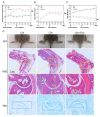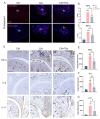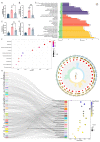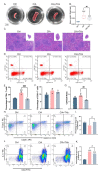Anti-Inflammatory and Immunomodulatory Effects of 0.1 Sub-Terahertz Irradiation in Collagen-Induced Arthritis Mice
- PMID: 38892148
- PMCID: PMC11172739
- DOI: 10.3390/ijms25115963
Anti-Inflammatory and Immunomodulatory Effects of 0.1 Sub-Terahertz Irradiation in Collagen-Induced Arthritis Mice
Abstract
The primary emphasis of photoimmunology is the impact of nonionizing radiation on the immune system. With the development of terahertz (THz) and sub-terahertz (sub-THz) technology, the biological effects of this emerging nonionizing radiation, particularly its influence on immune function, remain insufficiently explored but are progressively attracting attention. Here, we demonstrated that 0.1 sub-THz radiation can modulate the immune system and alleviate symptoms of arthritis in collagen-induced arthritis (CIA) mice through a nonthermal manner. The application of 0.1 sub-THz irradiation led to a decrease in proinflammatory factors within the joints and serum, reducing the levels of blood immune cells and the quantity of splenic CD4+ T cells. Notably, 0.1 sub-THz irradiation restored depleted Treg cells in CIA mice and re-established the Th17/Treg equilibrium. These findings suggested that sub-THz irradiation plays a crucial role in systemic immunoregulation. Further exploration of its immune modulation mechanisms revealed the anti-inflammatory properties of 0.1 sub-THz on LPS-stimulated skin keratinocytes. Through the reduction in NF-κB signaling and NLRP3 inflammasome activation, 0.1 sub-THz irradiation effectively decreased the production of inflammatory factors and immune-active substances, including IL-1β and PGE2, in HaCaT cells. Consequently, 0.1 sub-THz irradiation mitigated the inflammatory response and contributed to the maintenance of immune tolerance in CIA mice. This research provided significant new evidence supporting the systemic impacts of 0.1 sub-THz radiation, particularly on the immune system. It also enhanced the field of photoimmunology and offered valuable insights into the potential biomedical applications of 0.1 sub-THz radiation for treating autoimmune diseases.
Keywords: CIA mice; HaCaT; immunity; inflammation; terahertz irradiation.
Conflict of interest statement
The authors declare that they have no competing interests.
Figures






Similar articles
-
Transcriptomic Analysis of Blood Collagen-Induced Arthritis Mice Exposed to 0.1 THz Reveals Inhibition of Genes and Pathways Involved in Rheumatoid Arthritis.Int J Mol Sci. 2024 Nov 28;25(23):12812. doi: 10.3390/ijms252312812. Int J Mol Sci. 2024. PMID: 39684524 Free PMC article.
-
Protectin DX restores Treg/Th17 cell balance in rheumatoid arthritis by inhibiting NLRP3 inflammasome via miR-20a.Cell Death Dis. 2021 Mar 15;12(3):280. doi: 10.1038/s41419-021-03562-6. Cell Death Dis. 2021. PMID: 33723242 Free PMC article.
-
Taraxasterol suppresses inflammation in IL-1β-induced rheumatoid arthritis fibroblast-like synoviocytes and rheumatoid arthritis progression in mice.Int Immunopharmacol. 2019 May;70:274-283. doi: 10.1016/j.intimp.2019.02.029. Epub 2019 Mar 6. Int Immunopharmacol. 2019. PMID: 30851708
-
NLRP3 Inflammasome: Checkpoint Connecting Innate and Adaptive Immunity in Autoimmune Diseases.Front Immunol. 2021 Oct 11;12:732933. doi: 10.3389/fimmu.2021.732933. eCollection 2021. Front Immunol. 2021. PMID: 34707607 Free PMC article. Review.
-
Curcumin: an inflammasome silencer.Pharmacol Res. 2020 Sep;159:104921. doi: 10.1016/j.phrs.2020.104921. Epub 2020 May 25. Pharmacol Res. 2020. PMID: 32464325 Review.
Cited by
-
Transcriptomic Analysis of Blood Collagen-Induced Arthritis Mice Exposed to 0.1 THz Reveals Inhibition of Genes and Pathways Involved in Rheumatoid Arthritis.Int J Mol Sci. 2024 Nov 28;25(23):12812. doi: 10.3390/ijms252312812. Int J Mol Sci. 2024. PMID: 39684524 Free PMC article.
-
Assessment of the general clinical condition and functional properties of the eyes of rabbits after THz irradiation.Biomed Opt Express. 2025 Feb 13;16(3):1043-1061. doi: 10.1364/BOE.546147. eCollection 2025 Mar 1. Biomed Opt Express. 2025. PMID: 40109522 Free PMC article.
References
-
- Grundt J.E., Cerna C., Roth C.C., Ibey B.L., Lipscomb D., Echchgadda I., Wilmink G.J. Terahertz radiation triggers a signature gene expression profile in human cells; Proceedings of the 2011 International Conference on Infrared, Millimeter, and Terahertz Waves; Houston, TX, USA. 2–7 October 2011; p. 12442108.
-
- Echchgadda I., Cerna C.Z., Sloan M.A., Elam D.P., Ibey B.L. Optical Interactions with Tissue and Cells XXVI. SPIE; San Francisco, CA, USA: 2015. Effects of different terahertz frequencies on gene expression in human keratinocytes.
MeSH terms
Substances
Grants and funding
LinkOut - more resources
Full Text Sources
Molecular Biology Databases
Research Materials

